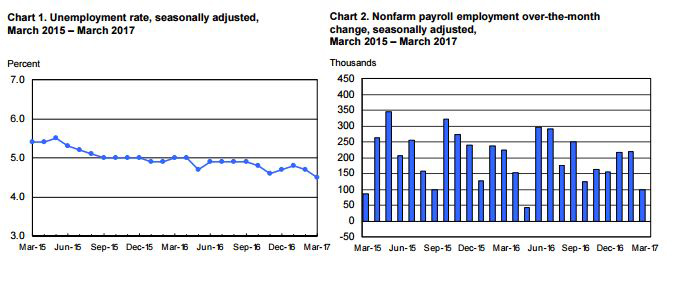
THE EMPLOYMENT SITUATION -- MARCH 2017
April 7, 2017 - The unemployment rate declined to 4.5 percent in March, and total nonfarm payroll employment edged up by 98,000, the U.S. Bureau of Labor Statistics reported today. Employment increased in professional and business services
 and in mining, while retail trade lost jobs.
and in mining, while retail trade lost jobs.Household Survey Data
The unemployment rate decreased by 0.2 percentage point to 4.5 percent in March, and the number of unemployed persons declined by 326,000 to 7.2 million. Both measures were down over the year.
Among the major worker groups, the unemployment rates for adult women (4.0 percent), Whites (3.9 percent), and Hispanics (5.1 percent) declined in March. The jobless rates for adult men (4.3 percent), teenagers (13.7 percent), Blacks (8.0 percent), and Asians (3.3 percent) showed little or no change.
In March, the number of persons unemployed less than 5 weeks declined by 232,000 to 2.3 million. The number of long-term unemployed (those jobless for 27 weeks or more) was little changed over the month at 1.7 million and accounted for 23.3 percent of the unemployed. Over the past 12 months, the number of long-term unemployed was down by 526,000.
The labor force participation rate remained at 63.0 percent in March, and the employment-population ratio, at 60.1 percent, changed little. The employment-population ratio has edged up over the year, while the labor force participation rate has shown no clear trend.
The number of persons employed part time for economic reasons (sometimes referred to as involuntary part-time workers), at 5.6 million, was little changed in March but was down by 567,000 over the year. These individuals, who would have preferred full-time employment, were working part time because their hours had been cut back or because they were unable to find full-time jobs.
In March, 1.6 million persons were marginally attached to the labor force, little changed from a year earlier. (The data are not seasonally adjusted.) These individuals were not in the labor force, wanted and were available for work, and had looked for a job sometime in the prior 12 months. They were not counted as unemployed because they had not searched for work in the 4 weeks preceding the survey.
Among the marginally attached, there were 460,000 discouraged workers in March, down by 125,000 from a year earlier. (The data are not seasonally adjusted.) Discouraged workers are persons not currently looking for work because they believe no jobs are available for them. The remaining 1.1 million persons marginally attached to the labor force in March had not searched for work for reasons such as school attendance or family responsibilities.
Establishment Survey Data
Total nonfarm payroll employment edged up by 98,000 in March, following gains of 219,000 in February and 216,000 in January. Over the month, employment growth occurred in professional and business services (+56,000) and in mining (+11,000), while retail trade lost jobs (-30,000).
In March, employment in professional and business services rose by 56,000, about in line with the average monthly gain over the prior 12 months. Over the month, job gains occurred in services to buildings and dwellings (+17,000) and in architectural and engineering services (+7,000).
Mining added 11,000 jobs in March, with most of the gain occurring in support activities for mining (+9,000). Mining employment has risen by 35,000 since reaching a recent low in October 2016.
In March, employment continued to trend up in health care (+14,000), with job gains in hospitals (+9,000) and outpatient care centers (+6,000). In the first 3 months of this year, health care added an average of 20,000 jobs per month, compared with an average monthly gain of 32,000 in 2016.
Employment in financial activities continued to trend up in March (+9,000) and has increased by 178,000 over the past 12 months.
Construction employment changed little in March (+6,000), following a gain of 59,000 in February. Employment in construction has been trending up since late last summer, largely among specialty trade contractors and in residential building.
Retail trade lost 30,000 jobs in March. Employment in general merchandise stores declined by 35,000 in March and has declined by 89,000 since a recent high in October 2016.
Employment in other major industries, including manufacturing, wholesale trade, transportation and warehousing, information, leisure and hospitality, and government, showed little or no change over the month.
The average workweek for all employees on private nonfarm payrolls was unchanged at 34.3 hours in March. In manufacturing, the workweek edged down by 0.2 hour to 40.6 hours, and overtime edged down by 0.1 hour to 3.2 hours. The average workweek for production and nonsupervisory employees on private nonfarm payrolls edged down by 0.1 hour to 33.5 hours.
In March, average hourly earnings for all employees on private nonfarm payrolls increased by 5 cents to $26.14, following a 7-cent increase in February. Over the year, average hourly earnings have risen by 68 cents, or 2.7 percent. In March, average hourly earnings of private-sector production and nonsupervisory employees increased by 4 cents to $21.90.
The change in total nonfarm payroll employment for January was revised down from +238,000 to +216,000, and the change for February was revised down from +235,000 to +219,000. With these revisions, employment gains in January and February combined were 38,000 less than previously reported. Monthly revisions result from additional reports received from businesses since the last published estimates and from the recalculation of seasonal factors. Over the past 3 months, job gains have averaged 178,000 per month.
Source: BOLS








